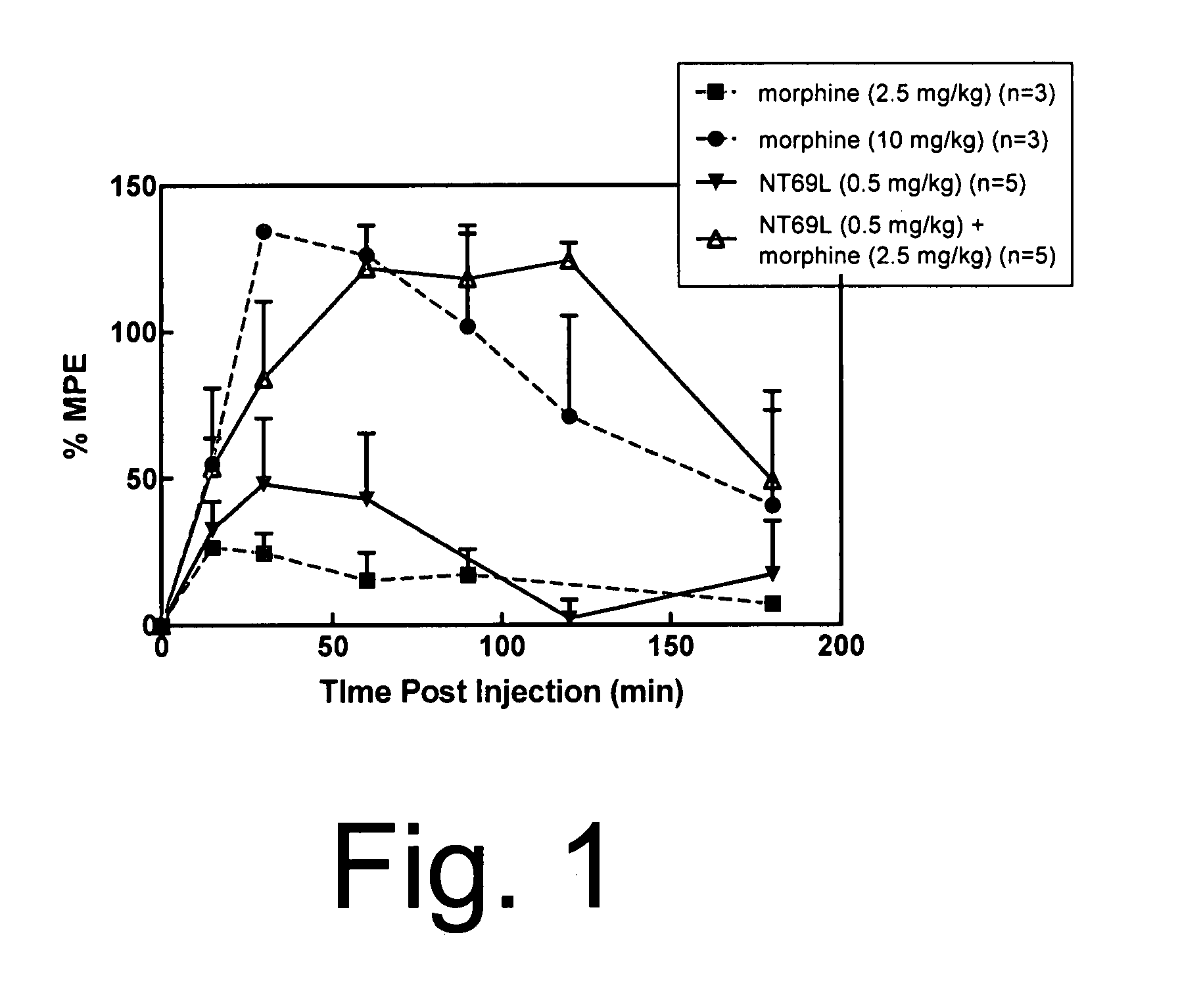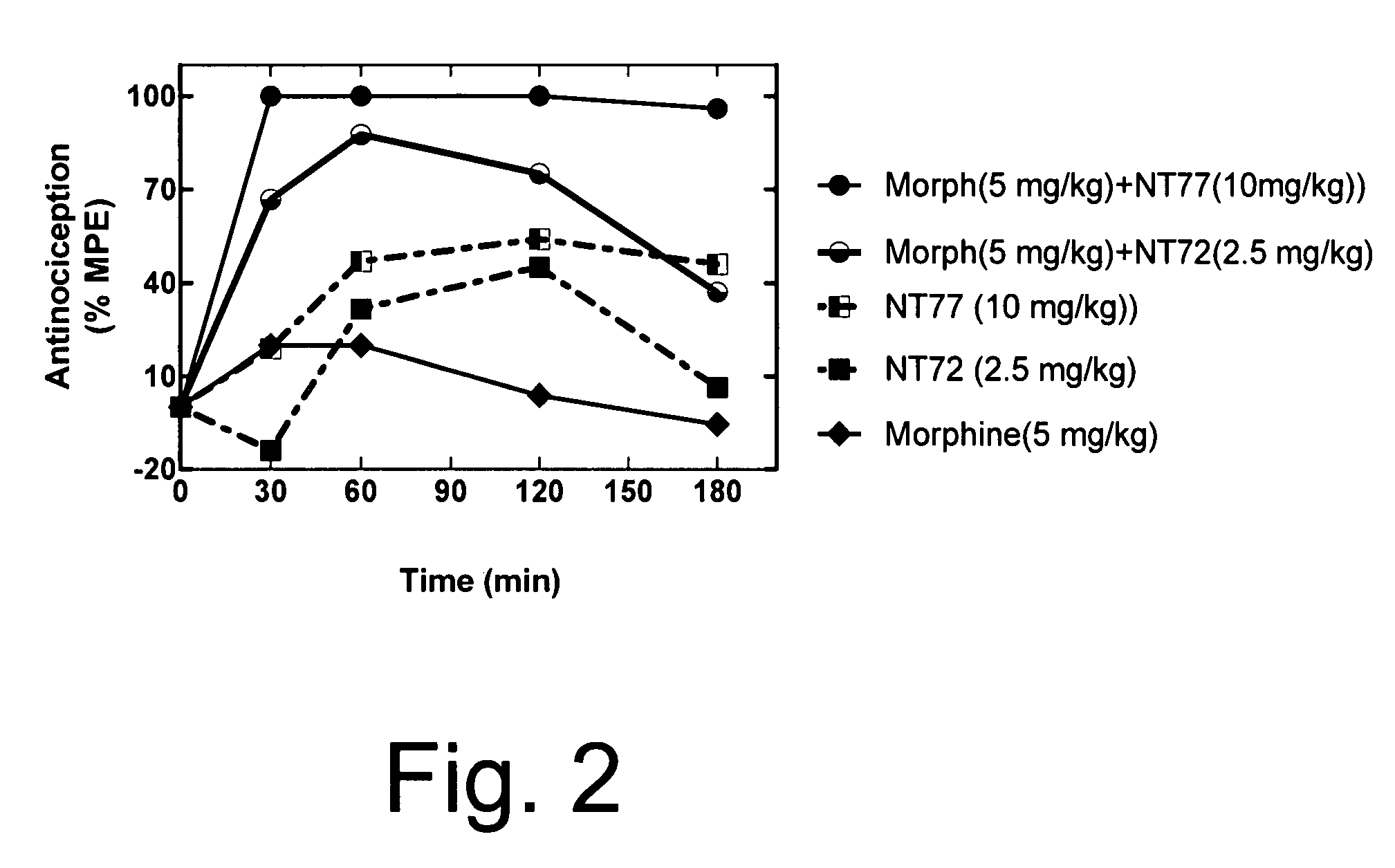Neurotensin receptor agonists and opioid receptor agonists
a technology of neurotensin receptor and opioid receptor, which is applied in the direction of drug compositions, peptide/protein ingredients, nervous disorders, etc., can solve the problems of severe respiratory depression, sedation, and reduced gastrointestinal motility, so as to minimize unwanted side effects of opiates and enhance the pharmacological
- Summary
- Abstract
- Description
- Claims
- Application Information
AI Technical Summary
Benefits of technology
Problems solved by technology
Method used
Image
Examples
example 1
Treating Pain Using a Combination of an NTR Agonist (NT69L) and an Opioid Receptor Agonist
[0061]Sprague Dawley male rats (150-250 g) were housed in a temperature controlled room with a 12:12 hour light / dark cycle and were given standard rat chow and water ad lib. Animals were injected with either NT69L or morphine or the combination of the two drugs in separate injections, one immediately after the other. All drugs were injected intraperitoneally. Fifteen minutes after the injection, animals were tested on the hot plate (time=0 on the graph of FIG. 1). The baseline hot plate data were obtained immediately prior to the experiment. The hot plate methods are described elsewhere (Tyler et al., Brain Research, 792:246-52 (1998)). Briefly, the hot plate was performed to determine pain sensitivity. The rats were placed on a metal plate (15×20 cm), maintained at a temperature of 52.5±0.15° C. The latency between the time the rat is placed on the surface and the time it licks either of its h...
example 2
Treating Pain Using a Combination of an NTR Agonist (NT72 or NT77) and an Opioid Receptor Agonist
[0063]As in Example 1, Sprague Dawley male rats (150-250 g) were housed in a temperature controlled room with a 12:12 hour light / dark cycle and were given standard rat chow and water ad lib. Animals were injected with either NT77, NT72, morphine, or the combination of morphine with either NT77 or NT72 in separate injections, one immediately after the other. All drugs were injected intraperitoneally. Fifteen minutes after the injection, animals were tested on the hot plate (time=0 on the graph of FIG. 2). The baseline hot plate data were obtained immediately prior to the experiment. The hot plate methods are described elsewhere (Tyler et al., Brain Research, 792:246-52 (1998)). Briefly, the hot plate was performed to determine pain sensitivity. The rats were placed on a metal plate (15×20 cm), maintained at a temperature of 52.5±0.15° C. The latency between the time the rat is placed on t...
example 3
[0065]Male CD-1 mice (25-30 g) are used in each example. Drugs are administered systemically via subcutaneous or intraperitoneal injections. Gastrointestinal transit is assessed by measuring the distance traveled by a charcoal meal (Paul and Pasternak 1988), incorporated herein by reference.
[0066]Analgesia is assessed 30 minutes post-injection using the radiant heat tail-flick assay. Baseline latencies range between 2.0 and 3.2 seconds. A maximal cutoff latency of 10 seconds is set to minimize tissue damage. Analgesia is assessed quantally as a doubling or greater of the baseline latency for each mouse. Quantal measures have long been used in this assay (D'Amour and Smith, 1941; Le Bars et al., 2001), as previously published by Pasternak et al, 19801a,b; Rossi et al, 1995, 1996; Neilan et al., 2001). Groups of mice are compared using Fisher's extract test. ED50 values and 95% confidence limits are calculated by probit analysis (Tallarida, 2000).
[0067]To assess the statistical signif...
PUM
| Property | Measurement | Unit |
|---|---|---|
| affinity | aaaaa | aaaaa |
| basal temperature | aaaaa | aaaaa |
| weight loss | aaaaa | aaaaa |
Abstract
Description
Claims
Application Information
 Login to View More
Login to View More - R&D
- Intellectual Property
- Life Sciences
- Materials
- Tech Scout
- Unparalleled Data Quality
- Higher Quality Content
- 60% Fewer Hallucinations
Browse by: Latest US Patents, China's latest patents, Technical Efficacy Thesaurus, Application Domain, Technology Topic, Popular Technical Reports.
© 2025 PatSnap. All rights reserved.Legal|Privacy policy|Modern Slavery Act Transparency Statement|Sitemap|About US| Contact US: help@patsnap.com


